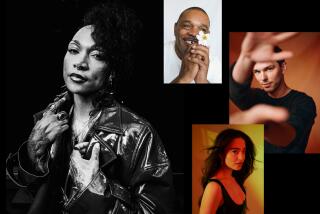Ronald Reagan was a foul-mouthed guy (when he was a movie star). . . . But look where he’s at now. : One Thing Leads to Another . . .
- Share via
Joe Jasgur lives in a cluttered apartment on the west side of Los Angeles in a area known as Palms. The living room is maybe 12 by 14 feet with a small kitchen off the side. With Joe’s photographic equipment and memorabilia stacked and scattered everywhere, there is hardly any place to stand, much less sit down.
When I entered the room I thought I was stepping into a warehouse and suggested maybe I ought to stay in the doorway and talk to Joe from there. But he wouldn’t hear of it and kicked some things aside and put a wooden stool in the center of the room and ordered me to sit.
Joe never sat at all. He kept busy digging through boxes and piles of prints to show me some of the 10,000 photographs he has taken of Hollywood celebrities over the past 48 years as a news photographer and prototype paparazzo.
“Take a look at this one,” he’d say, stepping over a word processor, moving some sepia-toned shots aside on a couch and reaching deftly to the exact place in a pile where he knew he would find a picture of Ronald Reagan, Humphrey Bogart and Harry Truman posing together in the 1940s.
“Ronnie was a Democrat in those days,” Joe said. “I used to follow him wherever he went. Nightclubs, private parties, you name it. He was a foul-mouthed guy, if you know what I mean. But one thing led to another and look where he’s at now.”
Joe stands barely 5-feet, 5-inches tall, dyes his hair jet black and has the quickest eyes I’ve ever seen. He is 69 and doesn’t look it.
The clutter in the room, some of which spills into the kitchen, is composed not only of prints and negatives but also of frames, viewers, mounting presses and a small fortune in stereo components.
Joe has been taking pictures since 1936 but gave it up for a while to play harmonica with a vaudeville band called the Harmonica Twisters. Later he went to work for a newspaper.
But the career for which he subsequently became famous began in Los Angeles in 1940. “I started free-lancing,” he said, “and one thing lead to another,” a phrase he repeats often to circumvent bothersome details of a story.
“They used to call me the demon photographer, because I could get pictures of people who wouldn’t cooperate with anyone else. I used practical psychology, you know?
“A guy came after me with a knife once and I said, ‘Hey, I just wanna tell your side of the story, buddy.’ Afterwards, he invited me to dinner.”
Lana Turner, Jack Benny, Rita Hayworth, Dorothy Lamour, Bette Davis, Harold Lloyd, Gary Cooper, Charlie Chaplin. . . .
Joe reads off the names as he jerks their pictures from stacks and boxes, a black-and-white history of an era trapped in rainbows, reduced now to storage in a dark apartment.
Marlene Dietrich, Tyrone Power, Betty Grable, Clark Gable. . . .
Al Martinez
The photographs he prizes most are the ones taken of Marilyn Monroe. Monroe died in 1962 at the age of 36, trailed to the grave by rumors of sexual trysts with John Kennedy, drug addiction, Mafia alliances and the possibility that she was murdered.
Joe has more than a hundred photographs of Marilyn, including one taken of her at age 19, when she owned only two outfits and didn’t have enough money to pay for the pictures.
“She was a strange little gal,” Joe said, looking over a life-sized cardboard cutout of Marilyn propped in a corner. She wore a two-piece swimsuit. Her hair was short and frizzy.
“She was Norma Jean Dougherty in those days, sweet and kind of chubby. She had six toes on her left foot. I’m the only guy with a picture of it. Count ‘em.”
I counted. There were six toes.
“After I took those first pictures, I bought her some food and we got to be friends. She tried to seduce me a couple of times to pay for the work I was doing, but I wouldn’t let her. She was always trying to prove she could have any man she wanted.”
He thumbed through her pictures from the first shots of a chubby Marilyn with an open smile to a Marilyn
beginning to assume the look that would blend sex and innocence into a firestorm.
“Women thought she was a bitch,” Joe said, “but I liked her OK. You had to get used to the fact that she never told the truth and made promises she never kept, but a lot of ‘em did that.
“You know, a year after I took her picture, I saw her at a premiere with some big stars and said, ‘Hey, remember me?’ She looked at me and said, ‘I don’t believe I do.’ I reminded her I was the guy she wanted to marry, and she just smiled and said, ‘I’m sorry’ and went on.
“One thing led to another and she was famous. Then she threw me aside.”
Joe looked around at his photos of the sex queen who has become a legend. Many of the pictures will hang in a Hollywood show in August commemorating the anniversary of Marilyn’s death.
He finally focused on the life-sized cutout again of the girl he remembered as Norma Jean, then shook his head and said mostly to himself, “If they only knew. . . . “


